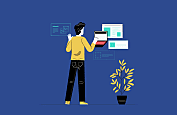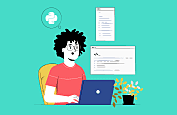
“The night is Dart and full of Flutters”
There’s a unique connection between a good sci-fi novel and its writer. Why? The writer not only presents the impossibilities in a lucid manner but the language with which he/she threads the story is like a magic potion. For eg- Philip K Dick’s ‘Do Androids Dream of Electric Sheep?’. Even the screen adaptation, ‘Blade Runner’ is cited as one of the best films ever made.
The language. The same applies to Flutter and Dart. Ever since Flutter came into existence, it has fascinated (also dominated) the programming world with absolute tenacity. After trials and tribulations with a number of programming languages, Google’s Dart was the one to be selected because as per programmers worldwide, it has garnered significant support as an exceptional language, and Flutter being modern and upbeat has synced perfectly with the former.
What is Dart?
Back in 2011, Dart was developed at the Google HQs by two programming masterminds- Lars Bak and Kasper Lund. It was created for for internal purposes that included building mobile, web and server apps. The semblance of its source code compilations can be found in JavaScript or other programming languages. The Dart VM has a self-stylised standalone Virtual Machine language that functions with the help of the Dart language itself. It also has its own package manager called Pub. Dart’s popularity became fourfold in late 2017 with Google’s official announcement for Flutter. The open-source mobile-app development framework was initially launched as a beta version and ever since Dart did not need to turn back.
But before I dive into the nitty-gritty, I put forth the following questions which helped me to understand the relationship:
- Is Dart capable of providing a faster route to a modern-day framework like Flutter?
- Are there too many jargons that Dart brings with it?
- Is the native specific customisation comparatively less difficult?
It's time to drop some #FlutterFriday knowledge! Q: Are you rewriting the same Flutter code over and over again? Make that a thing of the past with VSCode's code snippets or Android Studio's live templates. #vscode #androidstudio pic.twitter.com/wuh6sA1tm4 — Flutter (@FlutterDev) October 11, 2019
Notable features of Dart
- Because the Dart framework is a hybrid of both static and dynamic languages, developers find it quite easy to learn.
- For developers’ merry, Dart is Ahead of Time (AoT) is serving as an added advantage to script Flutter. AOT compilations make swift and preemptive native code giving supersonic wings to Flutter enabling all the widgets to be customised.
- Interestingly Dart also is Just in Time (JiT) which compiles speedy development cycles that help developers to create programs rapidly.
- Dart is known for its impeccable animations and smooth transitions (60 fps). An added advantage which Dart provides to Flutter since it starts at a faster speed in object allocation and garbage collection and no preemptive scheduling which bars locks.
- Many frameworks have separate visual interface builders but with Dart, the problem is easily avoided. The language forestalls the requirement for any distinct declarative layout language for Flutter like XML or JSX because Dart itself is so easy to read and comprehend. Because of the organised programmatic layout structure of Dart, it becomes simpler for Flutter to bring in advanced tooling.
How Flutter uses Dart
For installing, if you trail around Flutter Docs, you’ll get specific details on setting up the Flutter SDK and also the IDE you prefer, say VS code. The VS code is advantageous as it’ll guide you with in-built commands.
To create your first app, you can run the extension command, i.e., “Flutter: New Project”. You can proceed by giving the project a name and opting for a destination folder.
In the initial phase, you’ll see pubspec.yaml where you’ll find the app’s dependencies including all the ext. modules/libraries, along with images and configuration files. Inside the dependencies:section of the pubspec.yaml , you can find the packages that can be installed (package.json) by entering the name(s) and version(s) of the packages.
To include the assets of the app inside the flutter: section, you must run the command ‘flutter packages getget’.
main.dart is the pivotal access point to the app which you’ll get inside the lib folder. Here you can find app pages and reusable components (dart classes). The primary main.dart file is available with an existing written code. A device should be connected with enabled USB debugging (with the PC), before running the code. You are ready to run the command hereon.
Advantages of using Dart in Flutter
Languages like Kotlin have shown the world how fast and powerful they can be to develop the most efficient software development kit. So has Dart. The following points explain what makes the language so special for Flutter.
The Hot Reload
The most compelling feature of writing Flutter through Dart is the Hot Reload feature. With the help of a JIT compiler, you can go through the changes made in the code sans rebooting the build process in real-time. It enables the app to continue immediately from its last left state.
Widget
An abstraction in design can be either stateful or stateless. The state class is provided by the ‘redux’ Flutter, so you don’t have to pick. You can manipulate as per will. This is one amazing reason which companies choose Flutter for app development.
Scaffolding
Another UI abstraction feature includes scaffolding. The Flutter scaffold is quite different from iOS/React Native/Android UI building. But if you’re thorough with Facebook’s React Native, you’ll find similarities in Flutter. It’s like a UI library where you learn to compose different UI components.
Smoother is better than faster
A fast app is good but too much speed can make it stutter, rather the focus should be on making it smoother. But it’s easier said than done. You may find roadblocks while making it smoother. That’s why Dart is used to make it as unwrinkled as sliding through cheese. It provides the developer with several options to forge the app as peerless as he/she can.
The final wrap…
In less than 2 years, Flutter has proved its mettle, and Dart definitely deserves all the applause for it. Some amazing examples which can cajolingly called ‘The Flutter apps’ include Google Ads, Alibaba, Hookle, Watermaniac, etc. It is also worth knowing that Dart is used to write the powerful Google Fuchsia OS which is considered to become the most powerful software in the future.
So far so good, programmers love using it, and if you’re new to the language, more importantly, interested in learning it, I reckon this writeup helps you one way or the other.
Frequently Asked Questions
-
Why should you use Flutter?
Cross-Platform app development is currently the biggest driving force in the world of applications. The Flutter framework uses Hot Reloading, you can create an excellent UI with it, uses its own powerful rendering engine to create widgets. It’s written in Dart language which makes it one of the best open-source platforms to develop apps.
-
Flutter with dart- is it worth it?










